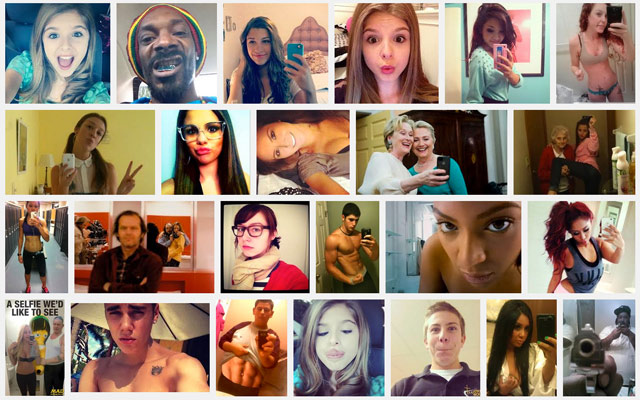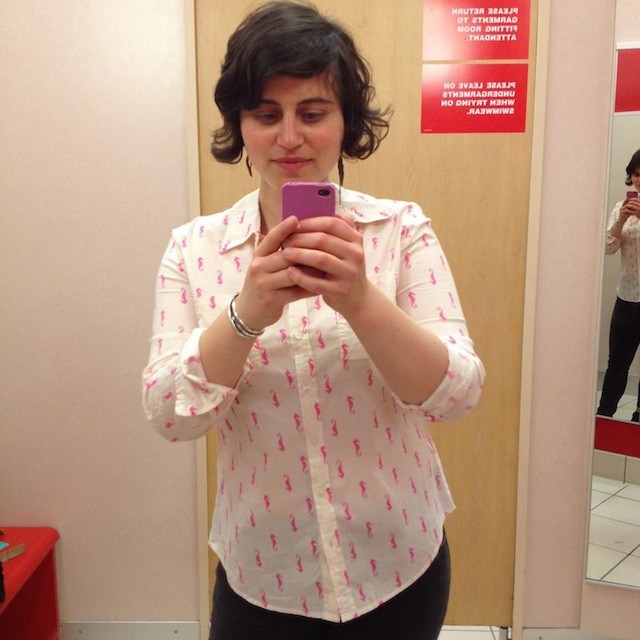From Hyperallergic, June 24, 2013, by Alicia Eler:

CHICAGO — People online have a lot to say about selfies: love them, hate them, feel indifferent about them, think they’re part of internet culture, a place we escape to, meld with our offline lives (making for a fluid but often fraught IRL-URL existence), something we learn from. If the selfie is the ultimate mirror in our internet house of mirrors, and we can frame our photos and curate ourselves as we want others to see us, then surely the selfie is an act of taking back the gaze. We look through the reversed mirror of the iPhone, into an actual mirror (camera flash reflection optional), or gaze longingly into a computer webcam. We self-consciously perform these moments from inside our private, domestic spaces, for ourselves and for our internet friends and “friends,” who are also voyeurs. They are our voyeurs, and we willingly welcome them into our curated worlds.
Yet the idea of self-portraiture is nothing new, nor is the act of people across the gender spectrum — adolescent and otherwise — photographing themselves. Does Cindy Sherman shoot selfies, self-portraits, or just cultural representations of women? Was Claude Cahun’s “Autoportrait” (1928) of herself looking androgynous in a black-and-white checked robe, appearing as a duality — a reflected version of herself in the mirror and a straight capture of herself confronting the camera — actually just a selfie? The tumblelog Lesbians Who Look Like Justin Bieber sports a surprising amount of selfies by people who in some way resemble the fluidly gendered adolescence embodied by teen pop icon Justin Bieber. Grindr has become synonymous with selfies, with men self-consciously documenting themselves in what is supposedly their most attractive state of being.
The selfie is also tied up in our consumer obsession with iPhones and Apple products — it can so easily become a SELFiE or iSELFIE by inserting the “i” of our Apple-driven consumer desires. The selfie (lowercase is the standard) is an aesthetic category, considered “cute” in both a pleasurable visual sense and paradoxically both selfish and selfless. The medium of the selfie may change depending on smartphone availability or the mirror, but the subject as object — and the object her/him/their/itself — is still the person whose self-image is always in flux. These selfies floating on the internet open up a space for a fluid, ongoing adolescence and discovery of the self.
In this new series for Hyperallergic, I’m asking you, dear reader, internet voyeur and selfie-obsessed individual, to share with me one single selfie and a bit about why you took it. We will continue every week with a new curated set of images submitted by you. Email your selfie and a 150–200 word explanation of why you shot it and what it means to: selfies [at] hyperallergic.com. Be bold, brave, and amazing, like a reality TV star. Be cute, zany, or interesting, like a modern consumer. But most of all, just be … yourselfie (YOLO, right?).
The series will begin by focusing on selfies created by people of all genders who find themselves questioning the Disney-ified beauty standards of American culture. We are told to make ourselves into beautiful “objects” for the mirror and for the gaze . The selfie explosion is an expansion of this idea, amplified by the fragmentation of the internet moment we live in.
To start things off, I present to you the first selfie that I consciously shot as such. It has since become my Facebook profile picture, my Gmail thumbnail pic, and my floating internet Gravatar. I snapped it with my iPhone in a dressing room at Target. It captures me in a semi-private space where the camera is not usually permitted (save for the corporation’s surveillance cameras) trying on a white button-down shirt covered in pink seahorses, which felt so adolescently girl-gendered that I had to take a shot of myself wearing it. There is a second mirror off to the side, reflecting back an image of me taking the selfie and allowing for a second glance from behind, a double-take that seems to support the epic question that we who look in mirrors ask: “How do I look?” This dressing room, which could have been any room in any Target in any major city, was my temporary house of mirrors — and yes, I do believe there are mirrors in paradise.

Share yourselfie with me and the internet! Email it to selfies [at] hyperallergic.com along with a 150–200 word explanation of why you shot it and what it means to you.



